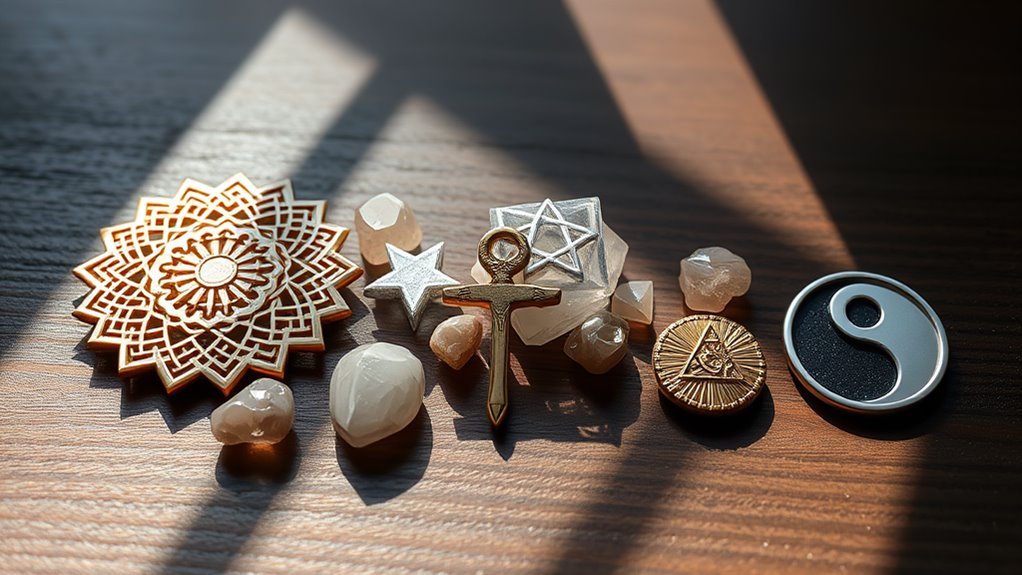Spiritual Meanings of Sacred Symbols: 11 Divine Signs
As we explore the meanings of sacred symbols, we find connections that link us to the universe and each other. Each symbol, such as the Om and the Mandala, provides insights into our lives. They act as tools for reflection and personal growth. What can we learn about ourselves through these symbols? Let's examine each emblem and its significance for our journey ahead.
Key Takeaways
- Sacred symbols like the Om help people connect with the universe. They promote inner peace and community through meditation and chanting.
- The Flower of Life shows how all things are connected. It encourages appreciation for our shared humanity and celebrates our diversity.
- The Ankh signifies rebirth and eternal life. It represents the union of opposites and inspires personal growth and transformation.
- Balance symbols, such as Yin Yang and Dreamcatchers, promote harmony and protection. They filter negativity and enhance spiritual insight.
- The Lotus Flower and Mandala represent purity and mindfulness. They encourage reflection on personal development and the ongoing journey of life.
The Om Symbol
The Om symbol is a sacred symbol in Hinduism and other spiritual traditions. It holds significant energy that invites us to connect with all existence.
During Om meditation, we focus on the gentle vibrations produced, helping to balance our minds and spirits. As we chant Om, we feel its energy flow through us, linking us to the universe and one another.
This ancient sound communicates directly with our hearts, reminding us of our shared experiences. Through this practice, we create a sense of community and awaken to the fact that we're part of something larger than ourselves.
Let's embrace the power of Om and find the peace within.
The Flower of Life
The Flower of Life is a symbol of creation and connection. Its geometric patterns remind us that we're part of a larger whole.
As we look at its circles, we sense unity and a bond that goes beyond ourselves. Each circle connects, showing the balance of life and love.
This symbol brings comfort and encourages us to share our journeys. The Flower of Life invites us to find our purpose, appreciate our shared humanity, and celebrate our differences.
Let's honor this symbol and strengthen the connections that unite us.
The Ankh
The ankh is a symbol of eternal life. It encourages us to explore existence and the cycle of rebirth. The ankh has a rich history in ancient Egypt, connecting us to those who valued its meaning.
The ankh represents the union of opposites—life and death, male and female. This symbol reminds us of our shared journey. Each encounter with the ankh draws us in, allowing us to feel the pulse of life within us.
Let's reflect on how this sacred emblem inspires us to honor our own cycles. It prompts us to appreciate moments of growth and transformation.
Together, we can celebrate the ongoing dance of existence that the ankh represents.
The Yin Yang
The Yin Yang symbolizes the balance of opposites. It reminds us that harmony comes from light and dark, joy and sorrow, strength and vulnerability. Each curve represents the balance we strive for in life. Neither force is better; together, they create wholeness.
When we think about Yin Yang, we see that our struggles and successes work together. This understanding leads to acceptance and deeper connections with others.
The Dreamcatcher
Dreamcatchers capture dreams and protect us. They come from Native American traditions and symbolize our connection to dreams and the spirit world. Each part of a dreamcatcher holds our hopes and filters out negativity, allowing good energy to enter.
When we hang dreamcatchers in our homes, we invite their protection. They remind us that we aren't alone during sleep.
Dreamcatchers honor the wisdom of our ancestors and create a feeling of belonging. They provide comfort, assuring us that our dreams are cared for with love and light.
The Eye of Horus
The Eye of Horus is a powerful symbol of protection and insight. It's rooted in Horus mythology and attracts those who seek guidance and safety.
This symbol speaks to the balance of life and the strength found in vulnerability.
- It represents divine protection and safety.
- It symbolizes clarity and heightened perception.
- It connects us to ancient wisdom and heritage.
- It encourages us to trust our intuition.
Embracing the Eye of Horus brings a sense of belonging to a lineage that values its protective meaning.
This symbol reminds us that we're watched over and guided, fostering a connection that's both reassuring and empowering.
The Lotus Flower
The lotus flower symbolizes purity and resilience. It grows in muddy waters, rising each day to bloom beautifully.
This journey represents our struggles and successes, showing that beauty can emerge from difficult situations. In lotus mythology, we find stories of rebirth and enlightenment. The flower connects the earthly and the divine.
The Pentacle
The pentacle is a strong symbol of balance and protection. Its history spans many ancient cultures, highlighting its meaningful significance.
This sacred symbol has five points, each representing earth, air, fire, water, and spirit. Here are its key aspects:
- Unity: It reminds us that all things are interconnected.
- Protection: It serves as a shield against negativity and harm.
- Balance: It symbolizes equilibrium in our lives.
- Spiritual Growth: It guides us on our path to enlightenment.
Embracing the pentacle brings comfort and wisdom, fulfilling our need for connection and understanding.
The Caduceus
The caduceus features two intertwined serpents and wings. It represents healing and balance. This ancient symbol connects us to important wisdom.
Many view it as just decoration, but it has deep meaning in our journey for harmony. The caduceus reminds us of the healing power we all possess, helping us face challenges in life.
The serpents symbolize our experiences, encouraging us to find balance in chaos. Each time we see the caduceus, we're invited to embrace our path of transformation.
Healing is both physical and spiritual. Together, we can use its energy to create a space where balance and wellness grow, uniting us in our shared goal of wholeness.
The Mandala
The mandala is a colorful pattern that invites reflection and unity. These designs help us find inner peace and strengthen our connection with ourselves and the universe.
Creating mandalas through art therapy can be a powerful way to express feelings and heal through creativity.
- Mandalas symbolize wholeness and balance.
- They promote mindfulness and presence.
- They build community through shared creation.
- They highlight our interconnectedness.
By embracing the mandala, we create a space where we can reflect, heal, and grow together.
This practice fosters a sense of belonging and encourages personal development.
The Infinity Symbol
The infinity symbol represents endless connection and continuity. Its curves remind us that life is a cycle where beginnings and endings merge.
Each loop signifies balance, teaching us the importance of harmony. In our lives, love, joy, and sorrow blend together, creating a richer experience.
This symbol encourages us to recognize our potential and embrace the possibilities within ourselves and others. Together, we celebrate the beauty of our connections, understanding that we're part of a greater whole, intertwined in the fabric of existence.
Frequently Asked Questions
How Can I Incorporate Sacred Symbols Into My Daily Life?
We can include sacred symbols in our daily lives through simple practices. Use meditation to focus on these symbols. Repeat affirmations that relate to them. This will create meaning in your life. By embracing these symbols, you invite their energy to guide your thoughts and strengthen your connections.
Are There Specific Rituals Associated With These Symbols?
Specific rituals can enhance the importance of sacred symbols. These practices help us connect more deeply with the symbols and each other. By engaging in these rituals, we create a sense of belonging and incorporate these meaningful traditions into our daily lives.
Can Sacred Symbols Have Different Meanings in Different Cultures?
Sacred symbols can have different meanings in different cultures. Each culture interprets these symbols in its own way. These variations show our shared humanity. While meanings change, our desire for understanding and connection unites us all.
How Do I Choose the Right Symbol for My Spiritual Journey?
Choosing the right symbol for your spiritual journey involves personal reflection and listening to your intuition. Focus on what resonates with you. This connection can guide your path and enhance your sense of belonging in this shared experience. Take time to explore different symbols, consider their meanings, and see which ones feel right for you. Trust your feelings as you make this choice.
What Materials Are Best for Creating or Displaying Sacred Symbols?
When we create or display sacred symbols, we appreciate the beauty of wooden carvings and metal engravings. Each material has its own unique energy. These materials help us connect with our spiritual journey. Using wood or metal can enhance our experience and deepen our reflection on shared beliefs. Choose materials that resonate with you for a more meaningful connection.

Hi, I’m Ethan—a spiritual wordsmith at SpiritualDivineInsight.com. My passion lies in exploring the mysteries of spirituality and sharing transformative insights. Through my articles, I invite you on a journey of self-discovery and mindfulness. Join me as we navigate the path to enlightenment together.







